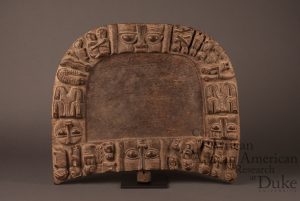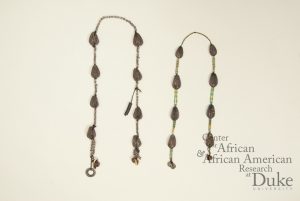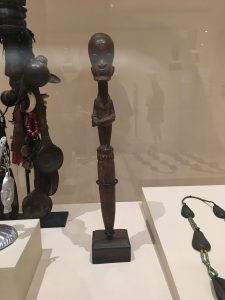Alyssa Falco
Ifa Divination isn’t an altar, it’s not part of an altar. It doesn’t belong on an altar. So instead when it’s in a museum where altars are present it gets represented on the wall and in a case. It hangs on the left wall in the room with the Haitian vodou altar. What makes me curious, is that divination is a Yoruba religion practice. Then I notice it’s tucked behind a long display case. This brown wooden tray sits back behind the case. It wouldn’t be the first object you notice walking into the room. Then as I walk closer, the detail of the 4 inch board starts to become more vivid. There are faces and there’s animals, looks like armadillos and horses, and designs that are unknown but have a snake structure to them. The details on the face are flat and smooth. The grooves along the face are deep. But what’s different is that each design looks like it’s pointed towards the middle. Like something should be demonstrated there, like a stage for a show. But the center in blank. Nothing but smooth, hard, brown wood. The whole board is about a foot and a half by a foot and a half and about 1-2 centimeters thick. There are two big faces, the biggest face at the top of the board. It has a flat nose and big protruding eyes. When looking at the board it’s the first carving that really pops out. I notice there is some symmetry that is on the board. The faces are across from each other, then there are the snake like designs on the left and right side of the board and then there are people and animals that looked scattered at first but then when you take a closer look you notice that they have some sort of pattern. There are two people, one of each sex, embracing on either side of the big face and they each have some sort of animal around them. Then there are other people around the board looking like the animals or the objects next to them have some sort of purpose next to them. Then as I read the description there are more parts that are described with this tray. There were two more items listed; pair of divination chains and the divination tapper. It then goes on to describe this thing, a babalawo or what they also called it the “father of mysteries” so of course this “father of mysteries” is just, that a mystery to me. So naturally with my curiosity getting the better of me I wanted to know more about what these mysteries were that the secrets of the babalawo. As I continue to read the description there is mention of Ifa, the first of the diviners. This again makes me wonder what the story is behind these diviners, what do they do? The description mentions that they have to memorize 256 odus. Which were poems, tales and prescriptions from the god Ifa himself. This was something that baffled me. Who could possibly remember that many poems, let alone some of them being stories. To me that was just insane. Naturally my curiosity grows. Then I take a look at these object, the chains and the tapper that is being described in the article. The chains are in a glass display case to the left of the tray. One of the chains didn’t really look like a chain. The other one however, was a made out of actual chain links. This one made sense to me, the small, grey chain links that is made out of chain links. At one end of the chain links there is one washer, one small white shell and one small brown shell. The other end has one bell, a small white shell and one small brown shell. I noticed these bigger black shells that were present in each of the two chains. There was 8 in both of them. Then between the fourth and fifth shell there was a bigger gap that split the chain into two halves with four shells on each half. This again made me curious. How could these chains fit with this board. Do they hang them? Do they form some sort of pattern that corresponds to the board? Each shell on the first chain is separated by a yellow blue pattern of beads. At one end there is a washer and one small white shell. On the other end there is one small bell present. The questions continued to fill my head. Now I look at the tapper, also found in the same display case as the chains. Now my head really has some questions. This tapper is different, nothing like I’ve ever seen before. First, thing I notice is the huge head that this man has. It’s a giant head. Looks like it hold so much information. The man sits upon this upside down cone. I go back to his head, he’s bald, he has this one protruding thing about his left ear. Almost looks like a tuft of hair. His head making him look very top heavy, if it were to be picked up. His neck is also incredibly long and skinny and he has a necklace around it. He hold something in each hand, looks like something flat and square in one hand and in the other he holds something to write with. All of this is made out of carved, solid, polished wood. If it’s name has anything to do with what it does, then I couldn’t imagine how. I don’t foresee this object being tapped on something. It’s to detailed to oddly shaped to be tapped on something. Just from looking at these objects I don’t know what to think. There are so different from anything I’ve ever seen. I wanted to know more about how these things so different could possibly fit together. Thus the questions soon lead to answers.
I had some background information of Ifa. He was the first of the diviners, so this means that he must be the oldest babalawo. As I continued my research another god kept popping up, Orunmila. The book Ifa Divination; Knowledge, power and performance made Orunmila more clear; “ Orunmila refers to exclusively to the deity himself, the name Ifa refers to both the deity and his divination system.” (51). Deity is another term for god, and from this Orunmila and Ifa are the same god, Ifa just refers to this process of divination itself. Therefore when Ifa and Orunmila are mentioned during the divination process, the communication could come from either of the gods. I look at the first of the three objects, an image can be found at the end of this paragraph. On the top of the tray there was the biggest carved face. This face will represent Eshu, he is the messenger god. Some representation of Eshu is present on every divination tray. This is because Eshu can be known as a trickster as well and to have him on the client’s side so they can get their information from Ifa then Eshu must be happy and represented as well. Therefore, Eshu is the god the babalawo is connecting to and Eshu is connecting to Ifa to the transfer the information to the babalawo. During Divination, Eshu is faced towards the babalawo, which forms a diameter that gives Eshu no shame in being present on both halves of the diameter, because he is known to be the only god who directly communicates with humans, therefore, they don’t want Eshu to be looked down upon (Dialogue and Alliance 28). There must also be sacrifice giving to Eshu before the divination can start as well. The other designs on the board are never to be constant out of respect for Eshu. Meaning that the other carvings differ from board to board making each one unique (Dialogue and Alliance 26). However, this brought up another question to myself; why would these objects be present in the gender corner or the museum? The other carvings that are part of the board, usually represent other Yoruba life tasks. This would explain the animals, it could be the sacrifices, the loving embrace is reproduction, and so on. The most important carving is Eshu, which is clear that it is important in this Tray. However, this is only one of three very intricate objects.

The chains is the next object that came to my attention, an image can be found at the bottom of this paragraph.The 8 shells on each chain was constant in both, so I did some research on this as well. These chains are used to be tossed on the board and some sort of pattern will come from this. The shells have a smooth side and a rough side. The babalawo uses the chains to cast patterns that will either show the shells facing the smooth side or the rough side, then the number of shells on either side is recorded. There are a total of 16 sections of odu that the babalawo has to work with. Each pattern will represent a different section that the babalawo has to interpret. There are a total of 16 shells or nuts because it is said that when Ifa left earth his children climbed a tree and in return he gave the each 16 nuts (Thompson 34). Another thing that seems to come up with this tree is white powder. This white powder also comes from this same tree and is used during divination to be sprinkled over the tray so the babalawo has something to record the patterns he sees that form from the shells (Thompson 35). There are 8 on each chain and 4 on each half because when the babalawo is recording the patterns the way the possible combinations will equal 16. (http://thewitchesalmanac.com/yoruba/) This is just a faster way to obtain these patterns instead of using just 16 shells off the chain. Most babalawos prefer to use the chains because it is a faster method.

Every Babalawo uses a tapper. An image of the tapper being described can be found at the bottom of this paragraph. The tapper has a very easy job. It simply summons the gods, Ifa and Eshu. To bring to them their attention that there is a divination going on and they need them to participate. A tapper can have many different looks. It all depends on the artist who made it. Because I don’t have the artist at my disposal, I like to draw some conclusions as to why the tapper may look like this based on my knowledge. I think the size of the head represents that number of odus the babalawo has to memorize. There is so much information that he has to memorize that it makes his head swell with all his knowledge. I believe the flat square object in this hand is a divination board and the other is a tapper as well, but a much smaller version. I think the man himself, represents the babalawo. I did find out why the man sits on a cone like structure. It is actually supposed to represent a tusk, and elephant tusk. In the Yoruba religion the cone is a ideogram for ashe. Ashe is divine power. Which represents all the power that is present and is needed for a divination ceremony. Therefore, the tapper is thus represented in this way (https://collections.dma.org/artwork/5327077). Now that reason for the shape and appearance of these objects is known and how these objects are used, I can finally look at why somebody in the Yoruba religion might want to even have a divination performed for them in the first place and I can look more at the babalawo himself who is a very important man in this ceremony.

In a normal human life there are some bumps in the road that may need some resolving. So a person may go to therapy and talk with somebody to work through their problems and perhaps get some guidance. Now if we look at people who practice the African Diaspora religion, they do the same thing, but instead of going to see a therapist, they go to see the babalawo. A babalawo is a messenger of sorts. He performs the divination for the client and then he recites what happens in the terms of verses or stories that he must memorize. Each story, or odu, has a meaning, and that meaning will correspond to what is going on in the client’s life. Then sacrifices can be made to try and get the good fortune back. When the babalawo is initiated into this priesthood, after about 12 years of training, he must memorize the 256 odus that can be recited during divination. Now you may wonder how an odu may be displayed during divination, well there are no words that give you hints. There is a chain that is tossed on the divination board, where this marking and reading happens. The chain consists of 8 shells with a smooth side and a rough side. The chain in thrown 16 times and the babalawo marks down on the tray what the results of the shells were when they were tossed, whether or not they landed on the rough side or the smooth side. This pattern will then describe what odu, Ifa is trying to relay to the client. The babalawo must recite what is being said by Ifa and express that to the client without knowing any information about why the client might be there to begin with. This is strictly the job of a babalawo, he performs Ifa Divination is whole life until his time is up. There are many different reasons why somebody might need to have a divination performed.
Ifa divination is a process that is used maybe during a milestone in somebody’s life. For example a newly married couple may go to divination to then look to their future. Somebody might go when they are looking from some insight into a new job they are starting. Maybe they would go if the just had a family member die and somebody else was sick in the hospital and they just feel like they need a change or have no more go fortune left in them. These people then go to this babalawo to have them perform a divination for them. They look to Ifa to give them some hope to hopefully turn their life around or point it in the right direction. This ceremony may often end in a sacrifice that the client might need to do. The sacrifice may be an animal or a gift for Ifa. This sacrifice will be a thanks to Ifa for the knowledge that he gave the client on the future and in hopes for good fortune.
The museum exhibition four different altars that represent each religion. Then there are objects that also fit into each religion based on what they may represent. The divination items can be found in the gender section of the museum. At first this may be very puzzling. However, when you take a closer look at the objects, you can see gender is displayed in them. The tray has carvings of both male and female showing their dependency on one another in everyday life, but also their independence they display. The embracing is needed of both sexes. But then some things there is only one person present at a point in the tray border. Symbolizing that each gender can be independent as well. The tapper itself is also a carving of a man as well. Then for obvious reasons this would fit into gender as well. I mentioned earlier that the tray’s carvings were pointed toward the center as if a show was going to happen. Now that the purpose of the blank middle, it is almost as though there is a show that it happening there. The messages from the gods is being conveyed in the center of this board. Now because the museum is full of altars, we can see that each altar has a show of its own. There are things present on each altar that are there for presentation to the gods they correspond to. In a way this is the same thing going on with the divination board. There is sacrifices that are made for the gods during divination just as there are for the altars. Maybe not a dead animal, but there are things present that are meant to give thanks to the goods, which is that same idea. The idea of divination itself is a ceremony that is for the people but it ties the gods into it as well. By asking them for their help or be asking them for a favor. The presence of an altar is again the same concept. It is made by the people and worshiped by the people because they want a sense of faith that they will have a good life as well. They feed their altars which then feed the gods to ensure a good life. Ifa Divination has the same idea. The people of these religions want to have a good life, they put their faith into their gods just as any other religion would. The objects that are used in Ifa divination put on an excellent performance and allow the people of the Yoruba religion to have faith that they will have a happy life, something that every person wants. Good fortune and a happy life.